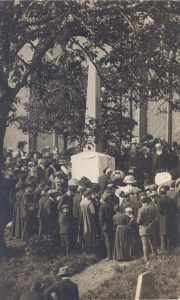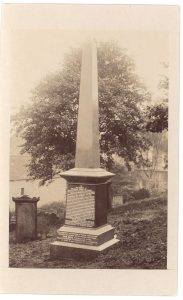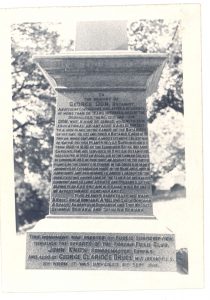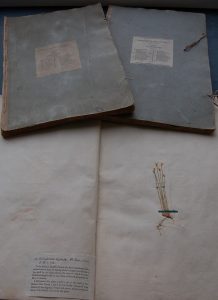George Don spent much of his life exploring the corries and glens of Angus and further afield to Arran, Ben Nevis and Skye. His plant collections in the early 19th C. from these remote places uncovered many species that had never been seen in Britain before and at times has led to a certain amount of controversy over their authenticity.
Don’s Botanic Garden at Forfar
George and his wife Caroline put down roots in Forfar in 1799 with a ninety nine year tenancy on ground to build a home and supply the Forfar with fresh fruit and vegetables. His market garden however became more of a botanic garden as his plant collection grew. A small plaque on Don Street, named in his honour, marks the former site.
Don produced a catalogue of plants for sale and from his ledgers, both in the RBGE archive, he sent plant material all over Britain. He was in regular correspondence with some of the most eminent botanists of the time, such as James Edward Smith, a founder of the Linnaean Society. His botanic garden was referred to as having the finest collection of hardy plants in the whole of Britain.
Two of George’s sons, George Don jr (1798 –
Royal Botanic Garden Edinburgh (RBGE)
In 1801 Don became Principal Gardener at RBGE through the urging of Patrick Neill and Sir James Brodie of Brodie, when the garden was located on Leith Walk. Don did not spend long in the post, resigning in 1806 due to friction with the Regius Keeper Prof. Daniel Rutherford, the restrictions of the city life and the challenge of sustaining his large family, he fathered 15 children in his life, on the £40 pounds per annum stipend.
The Botanics Cottage from Leith Walk that Don and his family would have stayed in during his time at RBGE is currently waiting to be reconstructed in the Demonstation Garden to be used as a teaching space.
Don Memorial
In 1910 a memorial to Geroge Don was unveiled in the Parish Church cemetery (now the East and Old Kirk) in Forfar. In the image below of the unveilling are three important figures to the right of the memorial (left to right): looking at the memorial holding his speech is Dr. G.C. Druce, next is John Knox a school master and president of the Forfar Field Club.
Don’s Collections & Herbarium Britannicum
Don’s plant collections were extensively used by James Edward Smith to describe plant species new to science. However, Don published three new species, in his Herbarium Britannicum: Sagina martima Don, the Sea Pearlwort; Raphanus maritimus Don, the Sea Radish and Myosotis alpina Don, the Alpine Forget-me-not. Herbarium Britannicum was published in 9 exsiccatae volumes between 1802 and 1813. Each volume consists of bound, dried, pressed and mounted specimens with a printed label with a scientific name, references and a description of where it was found. In the case of the three species mentioned above a validly and effectively published description.
Herbarium Britannicum is incredibly rare. There are only a handful of complete sets known to exist today with one at Royal Botanic Garden Edinburgh. RBGE also has at least one partial unbound set in the main British Herbarium that belonged to Professor John Hutton Balfour.
A collection of Don’s specimens came to RBGE through the Herbarium of Sir James Brodie of Brodie which was originally gifted to George Walker-Arnott. This example of Gentianella campestris shows the Brodie herbarium label and has an example of Don’s hand written label. The earliest specimens of Don’s in the collection at Edinburgh were in a bundle of plants given to William McNab as a gift from Patick Neill.
As early as 1802 Don was reporting species extinction; Eriophorum alpinum, now called Trichophorum alpinum, a widespread species in Europe and North America, that he and Robert Brown discovered for the first time in Britain 10 years earlier on Restenneth moss had become extinct due to peat and marl extraction. Then in 1813 in Don’s account of the Native plants and animals of Angus he was warning of the loss of more plant species from agricultural improvement fearing that some of the rarer sedges and grasses were under threat from draining of wet ground around Forfar.
For more information George Don and discussion about his Herbarium Britannicum see:
Evans, W.E. (1934). George Don’s Herbarium Britannicum. Notes from the Royal Botanic Garden Edinburgh. v.18 (n. 89) pp.167-172
RBGE Library archive holdings relating to George Don can be found here.
George Don’s publications exluding Herbarium Britannicum
Don, G. 1807. Observations on some of the Indigenous Grasses of Britain which seem deserving of Culture for Pasture or Hay. Prize Essays and Transactions of the Highland Society of Scotland, Volume 3:194-223





